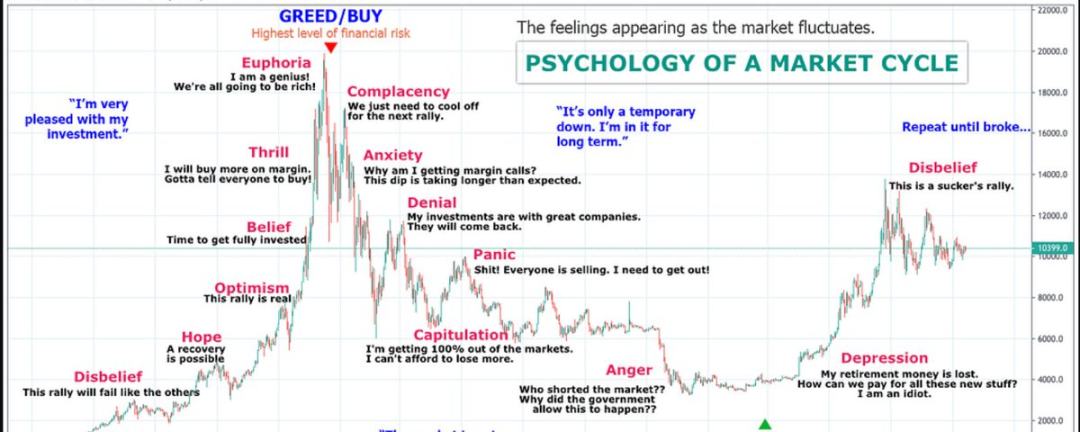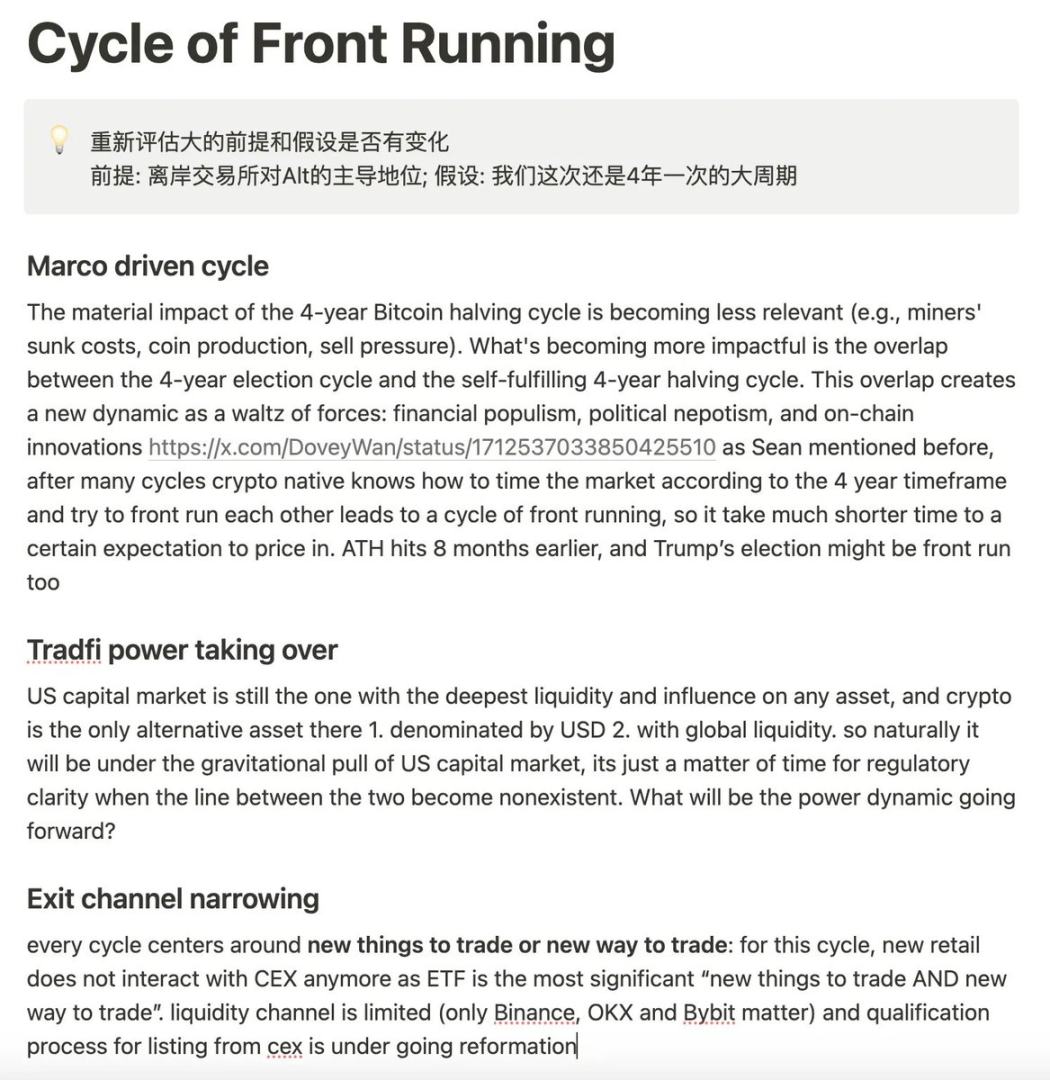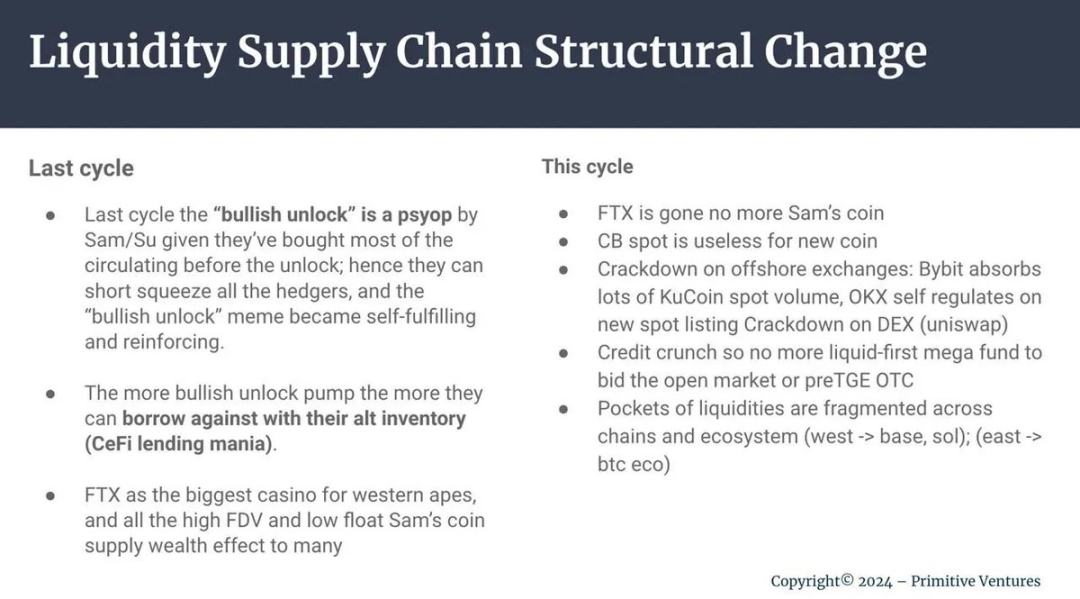The market is always swaying between long-termism and short-termism; it is a spectrum where Main Character and Meme will become the two ends of a Barbell, with market sentiment fluctuating accordingly.
Written by: Yetta
"Yetta, are you anxious about the market right now?" This was a serious question posed to me by someone at a dinner gathering. I was momentarily taken aback, not understanding why they thought we should be anxious. "Because many people believe that the rise of memes means VC coins are doomed, haha." The biggest topic of discussion at this Devcon was indeed about memes, and my peers joked that discussing primary markets would delay meme trading. Some even asked if we included memes in our asset allocation.
To be honest, we are not very anxious, or rather, we anticipated this situation back at the beginning of the year. Primitive is a evergreen fund without external capital, which allows us to view this industry through a longer time dimension. We also do not have the pressure of capital allocation; we do not need to explain to LPs who do not understand our industry why we invest in any track (often, LPs can be a huge pressure). Everything we do is driven by our curiosity to learn about the value and talent flow in this industry.
In the crypto market, which has become increasingly tiered and bubble-like, the definition of VC is actually closer to its essence: bet on things with venture return. Following any ideology or participating in any political struggle is meaningless; learning from the market is key.

First, let me share our understanding of the structural changes in the industry.
At the beginning of this year, we conducted a lot of reviews on the structural changes in the industry and wrote an internal report titled "Cycle of Front Running." TLDR: The polarization in our industry is becoming increasingly severe. On one hand, the industry is growing larger, with traditional finance integrating a large amount of crypto assets into Wall Street through compliant means like ETFs, which has siphoned off liquidity that is hard to convert back into our on-site funds. On the other hand, there is a strong expansion of populist capitalism, and the attention economy is further compressed. The entire financialization process is becoming increasingly simplistic and brutal, with the most crypto-native approach turning into direct meme trading, a realm that traditional finance cannot touch.

In this macroeconomic and social context, on-site liquidity is continuously shrinking. In the past, we said that the barbell strategy hoped for a fusion of both ends, but the result has been quite the opposite; our polarization has intensified. Thus, the middle state of our industry is becoming increasingly difficult.
Who does this middle state include? It includes all institutions that have risen due to the benefits of the grassroots era. Offshore CEXs, trading firms, crypto financial service providers, and VCs are all unable to escape this.
This structural change will make offshore CEXs anxious. The future open interest of CME has already surpassed that of Binance. If mainstream coins are increasingly traded in compliant venues due to traditional finance's entry, and memes can pump projects worth over 1 billion on-chain, then is Binance's space being squeezed?
In addition to Offshore CEXs, those market makers that previously relied on crypto are seeing high-frequency quant teams from Wall Street entering with their own infrastructure and capital. How will they break through? As they decline, the presence of third-party financial institutions that serve them is also diminishing, not to mention the VCs that cannot trade actively.
This polarization and liquidity squeeze are fundamental changes in our industry. Whoever finds the breakthrough point will be the one to succeed.
Next, what exactly is wrong with VC tokens?
I completely understand the market's sentiment towards VC tokens. Projects launch with extremely high FDVs, and after going live, they continuously unlock and dump for profit. Since it's all a casino, why not go to a relatively fairer casino and play meme PvP? If I lose, I can only blame my slow hands, rather than helping a multi-billion dollar VC coin take the fall.
What is the essence behind this problem? It is that our industry's liquidity supply chain has issues.
Why can Solana keep reaching new ATHs? Because they have real products that generate continuous profits for Sol, thus converting user communities into trading communities. The positive feedback loop between the two becomes a self-fulfilling prophecy, which is key to creating buy pressure.
The last cycle's DeFi was similar; products launched with minor innovations were fun, and DEXs created liquidity for continuous value discovery. Once the consensus between product communities and trading communities formed, CEX listings further released liquidity, achieving a three-way win for projects, communities, and CEXs.
A healthy ecosystem is one where those playing on-chain are willing to buy coins and are also willing to evangelize. This liquidity supply chain then enters a positive cycle.
And now? The problem with VC tokens is the split between these two communities. The mainnet launches with TGE, but the products have not landed, and the community is only there for airdrops, leading to sell pressure. In the last cycle, we had Sam/Su helping us leverage buy into Alts, but this cycle has seen leverage mostly cleared. Meanwhile, many VCs raised a lot of funds in the last bull market, creating pressure to allocate, and to show LPs attractive returns, they had to continuously push up project valuations.

This has led to the current situation of VC tokens, launching at high valuations with no buy pressure, leaving only the option to fall.
This naturally explains the logic behind the rise of memes. Since the projects that VCs invest in cannot land, and they are all just hot air, why not invest in something with a lower valuation that is fairer?
Memes have become one of the most significant opportunities in our industry that cannot be ignored or absent.
Under the polarization analyzed at the beginning of this article, memes have become one of the most significant tracks in our industry.
I always thought memes were purely speculative, but it wasn't until this time that I realized I was wrong. They are a carrier of cultural trends; their value lies not in specific functions and technologies, but in their unique ability to embody collective consciousness, emotions, and recognition, which is akin to the logic of religion. Beneath the absurd surface lies a profound social psychological need and value concept, tokenizing and capitalizing thoughts and emotions.
In other words, the core of its product is the thoughts and narratives it carries, and the size of these thoughts and narratives determines the ceiling of a meme. Cutting-edge technology, idol worship, IP emotions, subcultural trends—analyzing the potential behind them is just like how VCs analyze the prospects of a product's track and its position within that track.
For memes, the token is its product. Therefore, what it needs to do around the product is to promote the interaction between price and community. Price, in a sense, is the iterative development of the product, building a solid community foundation through the ups and downs of price, turning paper hands into diamond hands, encouraging them to spread the word, and ultimately fulfilling the self-fulfilling prophecy.
In this regard, meme tokens actually have a significant advantage that VC tokens lack. Because the token is the product itself, the product community and trading community merge into one, forming a synergy.
Memes have a low capital issuance, leading to a very low signal-to-noise ratio for investments, and they cannot be analyzed from tangible product forms. They require an excellent taste for understanding thoughts and market sentiment. I am still striving to learn whether there is a structured methodology to study this track, so as to select targets in a very low signal-to-noise ratio. If so, what kind of targets are suitable for our intervention and when should we intervene?
But I firmly believe that memes will become a cross-cycle opportunity because they are essentially a cultural phenomenon in the digital age. As thoughts remain immortal and emotions iterate, they will never run dry.
More importantly, I have always believed that providing opportunities for marginalized individuals to become wealthy is where the vitality of our industry lies. Before this wave of memes, it was said that the requirements for entrepreneurs in this cycle were ten times more than before, and it seemed that investments had all been consumed by VCs, with community and retail sentiment being greatly suppressed. However, through memes, young people can achieve 100x opportunities through early positioning. Anti-authoritarianism is one of the core spirits of crypto, and I believe it will always be there.
How long can memes last in this cycle?
When everyone is passionately feeling that they can sacrifice for the community and believe they can earn forever, don't forget that profit-taking will inevitably occur; this is an unchanging truth in the financial industry. Think back to whether the NFT community was the same: everyone took pride in using monkey avatars, helping them connect with brands, organizing events and collaborations everywhere, NFT parties spread globally, and then what?
When various inflated confidence and unrealistic expectations arise, when it seems that holding Major is not as good as holding Meme, and when various hacks and rugs appear, we should start to be vigilant. Once our industry lacks larger liquidity opportunities, and BTC begins to encounter resistance, all enhanced Alpha will fall faster.
By the way, isn't DeSci's logic similar to last cycle's PeopleDAO and the logic of saving Assange? Under the name of "justice," do we have the ability to distinguish between faith and speculation?
In fact, a significant turning point for memes occurred on Binance with the small Neiro. At that time, VC tokens were in trouble, and the breakthrough came when they discovered the small Neiro, embracing community memes that allowed projects, communities, and CEX users to profit, leading to ACT.
But now, does the blind liquidity of on-chain memes resemble the competition for TVL after high TVL projects on Binance, or the competition after the Ton ecosystem coins with huge user bases on Binance?
CEXs will change their listing strategies based on market expectations, thus guiding the market direction. Our industry, due to low asset issuance costs and liquidity premiums, will inevitably fall into a homogenized competitive chaos, which everyone will eventually become numb to and weary of.
This is the power of cycles.
In the short cycle, do not do anything just because CEX supports it; projects that genuinely contribute to industry building will emerge.
In the long cycle, bear markets will inevitably clear out those oversupplied entities that do nothing, bringing the market back on track.
The market is always swaying between long-termism and short-termism; it is a spectrum where Main Character and Meme will become the two ends of a Barbell, with market sentiment fluctuating accordingly.
There is no need to be anxious; just find your own rhythm.
Investment is a game like this. We make judgments based on our understanding and place our bets. If we are right, we make money; if we are wrong, we review. Always be curious, always be in awe.
免责声明:本文章仅代表作者个人观点,不代表本平台的立场和观点。本文章仅供信息分享,不构成对任何人的任何投资建议。用户与作者之间的任何争议,与本平台无关。如网页中刊载的文章或图片涉及侵权,请提供相关的权利证明和身份证明发送邮件到support@aicoin.com,本平台相关工作人员将会进行核查。




